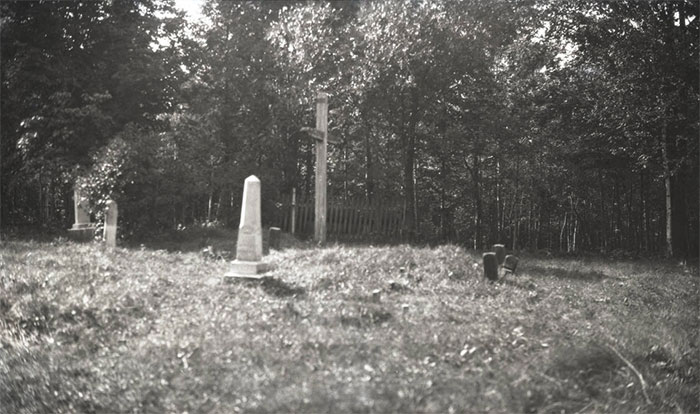Burials
Many traditional Ojibwe burial places are located within the Duluth-Superior area. Most have been obscured by past development, removed, or relocated to make way for railroad and road projects. Today, state laws protect burials from unauthorized disturbance.
16. Fond du Lac Cemeteries. Both Native and Euro-American cemeteries were located within Fond du Lac near the American Fur Company’s post. In 1869, in advance of the construction of the railroad, some burials were removed to the Roussain Cemetery. Evidence that some burials remained at the original Fond du Lac location is provided by a 1937 newspaper article that describes excavation work “on the new road” through Fond du Lac disturbing “an old Indian graveyard.” (Duluth News Tribune, August 27, 1937; Peacock 1998:44-45; Carlson 2000:23)
17. Roussain Cemetery. In 1869, burials from Fond du Lac were relocated to this cemetery located within Jay Cooke State Park. Established by Eustache Roussain, this cemetery was first used by the Roussain family and then, until 1914 or 1918, by the general community. It is unclear from historic records, how many burials were moved from Fond du Lac to this burial ground. The Roussain Cemetery is cared for by the Fond du Lac Band. (Koenen 2004; Peacock 1998:45)

Roussain Cemetery, 1927 (Photo from University of Minnesota-Duluth Archives and Special Collections)
18. Minnesota Point Burials. At least four Native burial grounds have been recorded along Minnesota Point often through the inadvertent discovery of gravesites during work on the point. However, as late as 1883, a burial ground near the point’s Franklin Square was still visible on a map of the city. (Wellge 1883)
19. Rice’s Point Burials. A burial ground was located at the base of Rice’s Point. Burials at this location were disturbed in 1870 by crews working on the Lake Superior and Mississippi Railroad in January of that year. (Duluth Minnesotian, January 29, 1870; Hall 1976:131)
20. Morgan Park Burials. Local histories in newspapers from the first quarter of the 20th–century indicate the presence of burial grounds within Duluth’s Morgan Park neighborhood. (Duluth News-Tribune, February 16, 1913; Duluth Weekly Advertiser, May 27, 1926)
21. Wisconsin Point Burials. An Ojibwe and French burial ground is located near the end of Wisconsin Point. In order to make way for planned docks, which were never constructed, burials were removed from the graveyard in 1918 and relocated to a mass grave within the cemetery of St. Francis Xavier in Superior. The location of the burial ground on Wisconsin Point is still marked and burials may remain on the point. (Diocese of Superior 2014; Ennis 2014).
22. Connor’s Point Burials. A mound and burials were reported on Connor’s Point in Superior. (Wisconsin Archeological Society 1914:56; Carlson 2012:7)
23. Billing’s Park. A burial ground was reported in the Billing’s Park neighborhood of Superior. (Superior Evening Telegram, July 15, 1894)
24. St. Francis Xavier Cemetery. In 1919, burials from Wisconsin Point were relocated to a mass grave in this cemetery along the Nemadji River. (Diocese of Superior 2014).
Copyright © 2022. All rights reserved.


